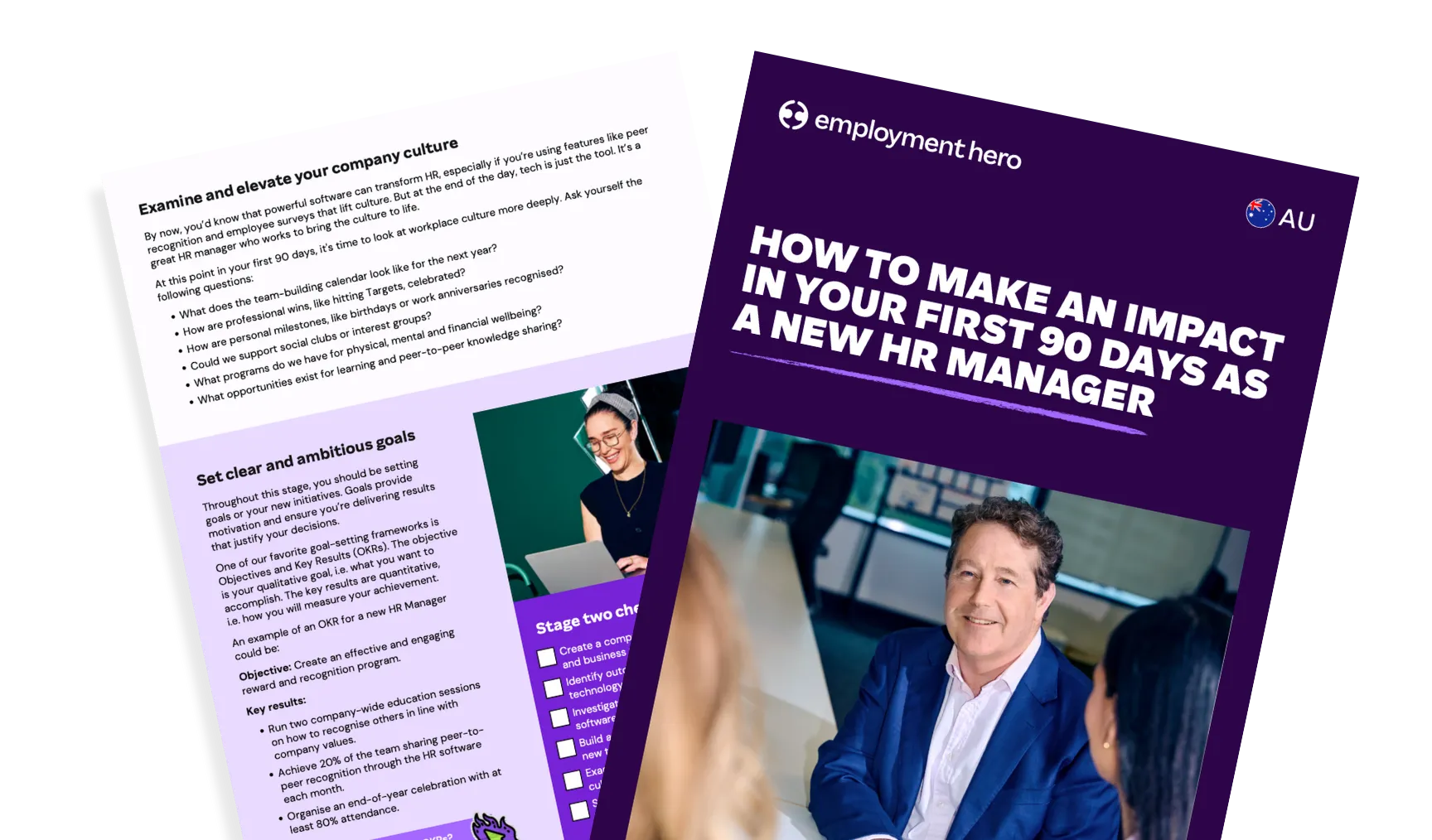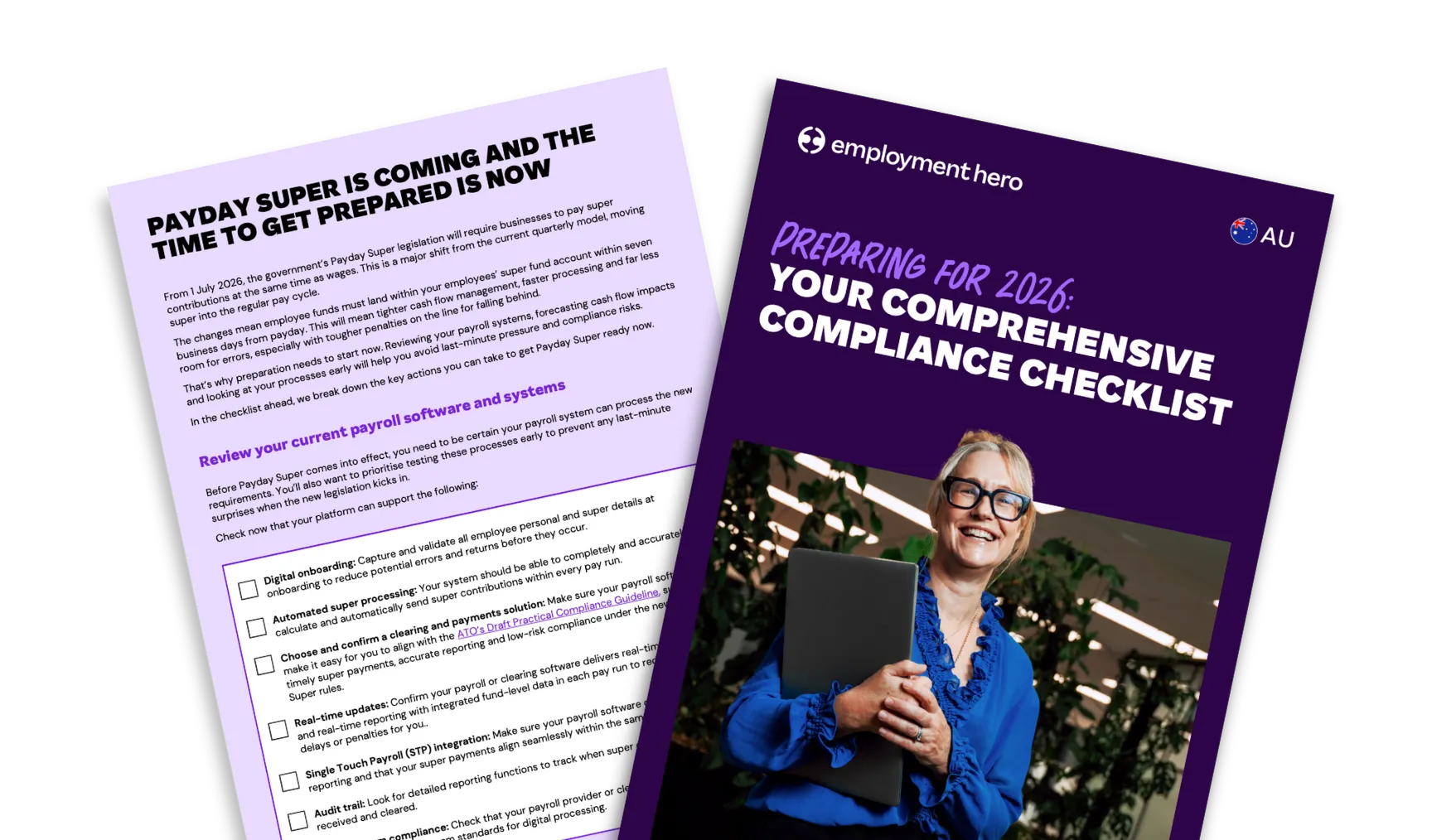What’s Causing Your Employee Retention Rate to Fall?
Published
What’s Causing Your Employee Retention Rate to Fall?
Is your best talent heading for the door? It’s time to challenge why. If your organisation is experiencing a spike in employee turnover, you’re not alone. Our survey of 1,000 Australian workers reveals an astonishing 48% are planning to look for a new role within the next year, with most planning their exit within just six months.
What is covered in this employee retention report?
Employee turnover concerns keep Human Resources (HR) leaders awake at night, and in today’s competitive labour market, finding and retaining top talent is increasingly challenging. Understanding what drives your employees’ decisions to stay or leave is essential for workforce stability.
The actions your organisation takes significantly impact your employee retention rate and recruitment success in this competitive talent landscape. This guide shares key findings from our survey of 1,000 Australian workers that uncovers what’s truly influencing employee movement and retention decisions.
Our research reveals:
- The scale and timing of intended job changes across different demographics
- Which employee groups represent your highest turnover risk
- The primary factors driving job-seeking behaviour
- Tips on improving employee retention you can implement immediately
- What genuinely matters to potential candidates in today’s market
- How to enhance your Employee Value Proposition for both retention and recruitment
- Practical insights to inform your people management approach
With employee turnover costs averaging 33% of annual salary per departure, addressing retention isn’t just about maintaining team morale; it’s a critical business imperative.
What are the common causes of low retention?
Understanding why employees leave is the first step toward building effective retention strategies. Several critical factors drive turnover across organisations of all sizes. You might find some surprising insights into what today’s employees truly value beyond compensation.
No focus on employee morale
Employee morale forms the emotional foundation of your workplace culture and directly influences retention. When organisations neglect the collective mood and outlook of their teams, the impact ripples through productivity, attendance and turnover rates.
Signs of declining morale often appear before resignation letters via increased absenteeism, reduced participation in team activities and a noticeable drop in effort. Watch out for moral issues and their potential to escalate quickly during periods of organisational change or when workloads increase.
For example, teams experiencing leadership transitions without proper communication support typically report significantly lower employee satisfaction and higher departure intentions. Regular 360-degree reviews, by offering multi-faceted feedback, can be a powerful tool to identify and address morale issues before they become major problems.
No focus on employee engagement
Employee engagement goes beyond simple job satisfaction to create a genuine connection between staff and their organisation’s goals. Disengaged employees might physically show up, but they’ve mentally checked out and are actively planning their exit.
Engagement issues manifest in various ways: reduced innovation, minimal participation in discussions, and declining quality of work. These problems often stem from employees feeling their contributions aren’t valued or their career development has stalled.
Organisations that fail to provide clear advancement pathways experience substantially higher turnover among high-potential employees, regardless of compensation levels.
Lack of career development opportunities
When employees can’t visualise their future within your organisation, they’ll look elsewhere for growth. The absence of structured development pathways, meaningful feedback, and learning opportunities consistently ranks among the top reasons for departure across all age demographics.
Consider the case of technical professionals who reach ceiling points without clear transitions to leadership or specialist roles—these employees frequently leave despite competitive salaries.
Similarly, organisations that fail to provide cross-skilling opportunities often lose valuable talent to competitors who offer more diverse experience portfolios, particularly among younger workers seeking varied skill development. Effective 1:1 meetings that focus on career progression, not just immediate tasks, can significantly impact retention in these scenarios.
Inadequate recognition and appreciation
People need to feel valued for their contributions. Without regular, meaningful recognition, employees develop a transactional relationship with their work, making them more susceptible to competitive offers, even those with modest salary increases.
This manifests in various ways across an organisation, from the sales team member who consistently meets targets but receives no acknowledgment beyond standard commission, to the operations staff whose process improvements go unnoticed despite significant efficiency gains.
Teams with managers who prioritise constructive feedback over positive reinforcement typically see higher voluntary turnover, regardless of industry or seniority levels.
Poor management practices
The old saying holds true that people don’t leave companies, they leave managers. Leadership quality and effective line management directly drive engagement and retention in ways that other factors can’t match.
Common problematic practices include micromanagement, inconsistent expectations, and poor communication. For example, department managers who frequently override decisions or fail to defend team resources experience a noticeably higher turnover.
Similarly, teams under leaders who lack emotional intelligence skills, particularly during high-stress periods, often see waves of resignations following major projects or organisational changes. When performance improvement plans are used punitively rather than developmentally, they often accelerate departures rather than addressing underlying issues.
Insufficient flexibility
The expectations around work flexibility have fundamentally shifted. Organisations that fail to accommodate reasonable flexibility requests face significant retention challenges, particularly among employees with caregiving responsibilities or those who’ve experienced the benefits of more adaptable working arrangements.
Consider the professional services firm that lost multiple high-performers after mandating full office returns without consultation, or the technology company that maintained rigid working hours despite project requirements that sometimes aligned better with alternative schedules.
Organisations that approach flexibility as a reluctant concession rather than a strategic advantage consistently struggle with retention across all demographic groups.
How can you calculate employee turnover rate?
Tracking your turnover metrics provides the essential baseline for any retention strategy. A clear understanding of your employee turnover rate helps you benchmark against industry standards and measure the effectiveness of your retention initiatives.
The standard formula is straightforward:
Employee turnover rate = (Number of separations ÷ Average number of employees) × 100
To calculate this effectively:
- Choose your timeframe: Monthly figures help identify immediate issues, while annual rates offer broader perspective
- Count separations: Include all departures during this period
- Calculate average headcount: Add your employee count at the beginning and end of the period, then divide by two
- Apply the formula: Divide separations by average headcount, then multiply by 100
For deeper insights, consider tracking:
- Voluntary vs. involuntary turnover: Distinguish between strategic adjustments and retention problems
- Departmental rates: Identify localised issues that company-wide figures might mask.
- Regrettable turnover: Focus on high-performers and critical roles
- First-year turnover: Early departures often indicate recruitment or onboarding issues.
A note on context: Industry averages vary significantly when assessing employee turnover. A 15% rate might indicate a crisis in one sector but represent healthy mobility in another. Always interpret your results within your specific industry, company size, and regional context for meaningful benchmarking.
What is a retention strategy?
A retention strategy is a structured approach organisations implement to keep valuable employees engaged, satisfied, and committed to remaining with the company long-term. It encompasses deliberate policies, practices, and programmes designed to address the key factors that influence staff decisions to stay or leave.
Effective retention strategies are proactive rather than reactive, aligned with broader organisational goals, regularly reviewed against measurable outcomes, and adapted as workforce preferences evolve.
Why do organisations need a retention strategy?
With nearly half of employees currently considering a job change, retention strategies have moved from optional to essential. The business impact of turnover extends far beyond the inconvenience of recruitment—it directly affects your organisation’s productivity, culture, and financial performance.
The financial case alone is compelling. With turnover costs averaging 33% of an employee’s annual salary, a company of 100 people experiencing 20% annual turnover could face replacement costs exceeding $500,000. This doesn’t even include the hidden costs of lost productivity, institutional knowledge gaps and reduced team morale.
Beyond cost savings, a thoughtful retention strategy delivers multiple benefits:
- Productivity continuity: Stable teams maintain operational momentum without the constant disruption of departures and onboarding.
- Knowledge preservation: Critical organisational knowledge stays within your company rather than walking out the door.
- Cultural strength: Core values and workplace culture are reinforced rather than diluted by constant personnel changes.
- Customer relationships: Client satisfaction improves when they build relationships with consistent team members.
- Talent attraction: Organisations known for employee longevity naturally attract better candidates.
The most effective retention strategies aren’t developed in reaction to resignations. They’re integrated into your broader talent management approach, addressing potential issues before they trigger departures.
How to identify your retention risks
Understanding where your retention vulnerabilities lie is the crucial first step before implementing any strategy. A data-driven approach helps pinpoint areas to focus your efforts.
Examine your turnover data for patterns. Look for disproportionate turnover among specific age groups, tenure levels, or departments. Timing patterns can reveal hidden issues, such as departures clustering around specific events like performance reviews or organisational changes. Tracking where departing employees go provides additional clues about what your organisation might be lacking.
Quantitative data, while essential, isn’t enough on its own. Regular stay interviews with key talent provide insights while employees are still committed. Review your engagement survey results for warning signs in specific teams or demographics, paying particular attention to questions about future intent and recommendation behaviour.
Not all turnover impacts your organisation equally. Prioritise retention efforts by identifying:
- Key roles where specialist knowledge makes replacement disruptive
- Future leadership pipeline positions essential for succession
- Customer relationship holders whose departure affects client retention
- Specialised technical roles with scarce talent pools
By mapping these factors against your turnover patterns, you can focus your retention strategies where they’ll deliver the most significant organisational benefit.
Retention strategies that don’t require huge budgets
We’ve explored why retention rates fall, how to calculate them, and common causes of departures. Now, let’s look at a clear takeaway: effective retention strategies don’t always demand significant financial investment. By focusing on connection, growth, and recognition rather than compensation alone, you can address key retention drivers without straining your resources.
1. Enhance career visibility: Career visibility often ranks among employees’ top concerns, yet addressing it requires minimal financial outlay. Create clear documentation of potential career paths within your organisation, highlighting both upward progression and lateral moves that build diverse skills. Regular career conversations between managers and team members provide another low-cost, high-impact intervention.
2. Strengthen team connections: The sense of belonging created through meaningful workplace relationships often counters the pull of external opportunities, even those offering higher compensation. Consider:
- Implementing structured onboarding buddies for new starters
- Creating cross-functional collaboration opportunities
- Establishing regular team recognition practices where members acknowledge each other’s contributions
3. Improve leadership practices: Leadership quality directly impacts retention, making manager development a high-ROI retention investment. Train your managers in effective one-to-one conversation techniques, focusing on active listening and coaching approaches rather than directive management.
4. Increase workplace flexibility: Workplace flexibility has emerged as a critical retention factor across industries and demographics. Review which roles genuinely require set hours or locations based on business needs rather than tradition. Implementing core collaboration hours with flexibility around them can significantly reduce turnover while maintaining productivity.
The most effective low-cost retention approaches combine these elements to address your specific risk areas. Rather than implementing generic best-practices, match your interventions to the concerns identified in your retention risk assessment. These approaches don’t require a significant financial outlay, but they do demand genuine leadership commitment and consistent implementation to deliver lasting results.
Ready for a deeper dive? Download our complete Employee Retention Report now and transform your strategy.
Time to put these insights to work? Discover how Employment Hero’s performance management system provides the structured framework you need to implement many of these retention strategies systematically. From documenting career pathways to facilitating regular check-ins and recognition, our platform helps transform retention theory into everyday practice.
Register for the report.
Related Resources
-
 Read more: Your first 90 days as an HR manager: a complete 30-60-90 day plan
Read more: Your first 90 days as an HR manager: a complete 30-60-90 day planYour first 90 days as an HR manager: a complete 30-60-90 day plan
Starting as an HR manager? Follow this 30-60-90 day plan to build trust, set strategy and make an impact in…
-
 Read more: HR Managers: Don’t just survive the festive season, master it
Read more: HR Managers: Don’t just survive the festive season, master itHR Managers: Don’t just survive the festive season, master it
Make year-end easier: manage leave, payroll, parties and shutdowns with confidence. Get practical tips for Australian SMEs. Download the free…
-
 Read more: Preparing for 2026: Your Compliance Checklist
Read more: Preparing for 2026: Your Compliance ChecklistPreparing for 2026: Your Compliance Checklist
Get your business ready for the 1 July 2026 changes. See practical steps for Payday Super, cash flow planning and…























